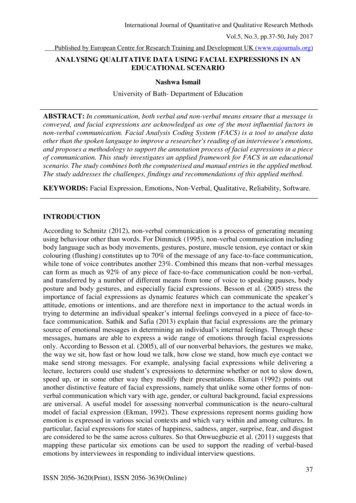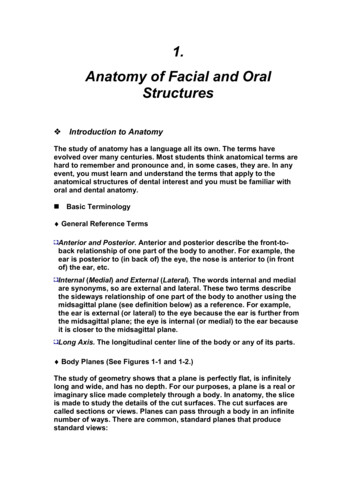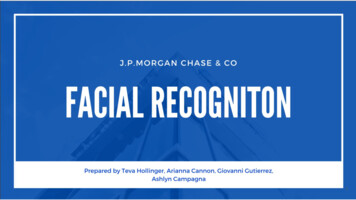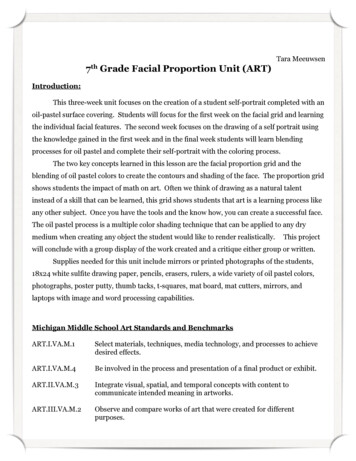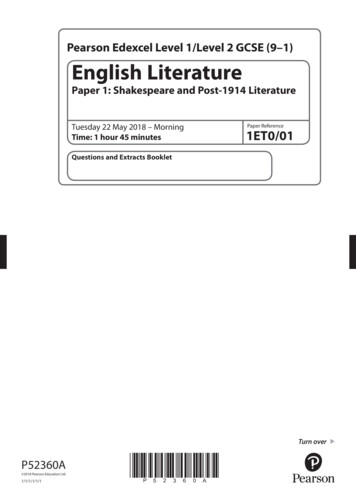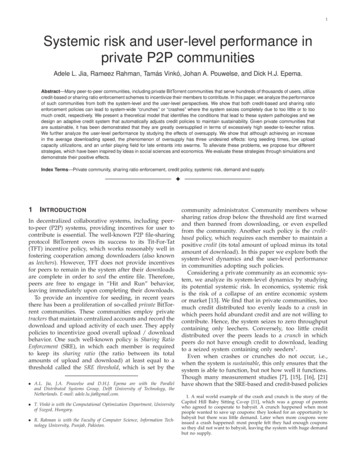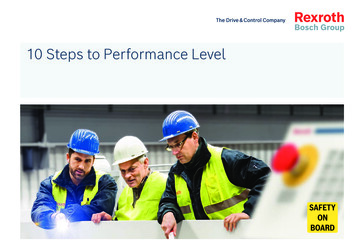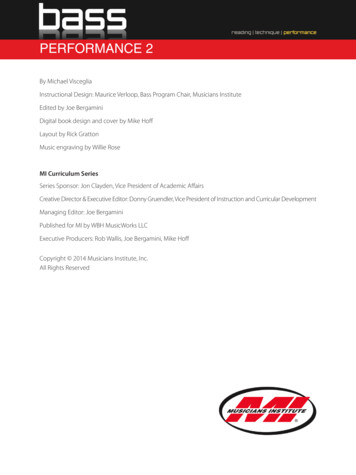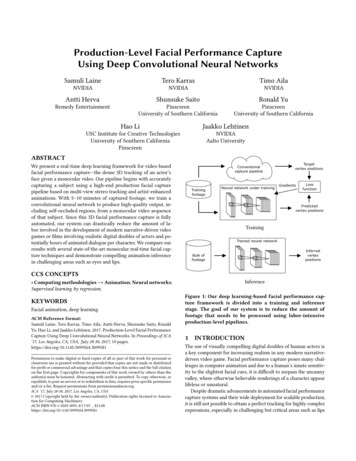
Transcription
Production-Level Facial Performance CaptureUsing Deep Convolutional Neural NetworksSamuli LaineTero KarrasTimo AilaNVIDIANVIDIANVIDIAAntti HervaShunsuke SaitoRonald YuRemedy EntertainmentPinscreenUniversity of Southern CaliforniaPinscreenUniversity of Southern CaliforniaHao LiJaakko LehtinenUSC Institute for Creative TechnologiesUniversity of Southern CaliforniaPinscreenNVIDIAAalto UniversityABSTRACTWe present a real-time deep learning framework for video-basedfacial performance capture—the dense 3D tracking of an actor’sface given a monocular video. Our pipeline begins with accuratelycapturing a subject using a high-end production facial capturepipeline based on multi-view stereo tracking and artist-enhancedanimations. With 5–10 minutes of captured footage, we train aconvolutional neural network to produce high-quality output, including self-occluded regions, from a monocular video sequenceof that subject. Since this 3D facial performance capture is fullyautomated, our system can drastically reduce the amount of labor involved in the development of modern narrative-driven videogames or films involving realistic digital doubles of actors and potentially hours of animated dialogue per character. We compare ourresults with several state-of-the-art monocular real-time facial capture techniques and demonstrate compelling animation inferencein challenging areas such as eyes and lips.Conventionalcapture pipelineTrainingfootageNeural network under trainingTargetvertex positionsGradientsLossfunctionPredictedvertex positionsTrainingTrained neural networkInferredvertexpositionsBulk offootageCCS CONCEPTSInference Computing methodologies Animation; Neural networks;Supervised learning by regression;KEYWORDSFacial animation, deep learningACM Reference format:Samuli Laine, Tero Karras, Timo Aila, Antti Herva, Shunsuke Saito, RonaldYu, Hao Li, and Jaakko Lehtinen. 2017. Production-Level Facial PerformanceCapture Using Deep Convolutional Neural Networks. In Proceedings of SCA’17, Los Angeles, CA, USA, July 28-30, 2017, 10 ssion to make digital or hard copies of all or part of this work for personal orclassroom use is granted without fee provided that copies are not made or distributedfor profit or commercial advantage and that copies bear this notice and the full citationon the first page. Copyrights for components of this work owned by others than theauthor(s) must be honored. Abstracting with credit is permitted. To copy otherwise, orrepublish, to post on servers or to redistribute to lists, requires prior specific permissionand/or a fee. Request permissions from permissions@acm.org.SCA ’17, July 28-30, 2017, Los Angeles, CA, USA 2017 Copyright held by the owner/author(s). Publication rights licensed to Association for Computing Machinery.ACM ISBN 978-1-4503-5091-4/17/07. . . 15.00https://doi.org/10.1145/3099564.3099581Figure 1: Our deep learning-based facial performance capture framework is divided into a training and inferencestage. The goal of our system is to reduce the amount offootage that needs to be processed using labor-intensiveproduction-level pipelines.1INTRODUCTIONThe use of visually compelling digital doubles of human actors isa key component for increasing realism in any modern narrativedriven video game. Facial performance capture poses many challenges in computer animation and due to a human’s innate sensitivity to the slightest facial cues, it is difficult to surpass the uncannyvalley, where otherwise believable renderings of a character appearlifeless or unnatural.Despite dramatic advancements in automated facial performancecapture systems and their wide deployment for scalable production,it is still not possible to obtain a perfect tracking for highly complexexpressions, especially in challenging but critical areas such as lips
SCA ’17, July 28-30, 2017, Los Angeles, CA, USAand eye regions. In most cases, manual clean-up and corrections byskilled artists are necessary to ensure high-quality output that is freefrom artifacts and noise. Conventional facial animation pipelinescan easily result in drastic costs, especially in settings such as videogame production where hours of footage may need to be processed.In this paper, we introduce a deep learning framework for realtime and production-quality facial performance capture. Our goal isnot to fully eliminate the need for manual work, but to significantlyreduce the extent to which it is required. We apply an offline, multiview stereo capture pipeline with manual clean-up to a small subsetof the input video footage, and use it to generate enough data totrain a deep neural network. The trained network can then be usedto automatically process the remaining video footage at rates asfast as 870 fps, skipping the conventional labor-intensive capturepipeline entirely.Furthermore, we only require a single view as input duringruntime which makes our solution attractive for head cam-basedfacial capture. Our approach is real-time and does not even needsequential processing, so every frame can be processed independently. Furthermore, we demonstrate qualitatively superior resultscompared to state-of-the-art monocular real-time facial capturesolutions. Our pipeline is outlined in Figure 1.1.1Problem StatementWe assume that the input for the capture pipeline is multiple-viewvideos of the actor’s head captured under controlled conditionsto generate training data for the neural network. The input to theneural network at runtime is video from a single view. The positions of the cameras remain fixed, the lighting and background arestandardized, and the actor is to remain at approximately the sameposition relative to the cameras throughout the recording. Naturally,some amount of movement needs to be allowed, and we achievethis through data augmentation during training (Section 4.1).The output of the capture pipeline is the set of per-frame positions of facial mesh vertices, as illustrated in Figure 2. Other faceencodings such as blendshape weights or joint positions are introduced in later stages of our pipeline, mainly for compressionand rendering purposes, but the primary capture output consists ofthe positions of approximately 5000 animated vertices on a fixedtopology facial mesh.1.2Offline Capture PipelineThe training data used for the deep neural network was generatedusing Remedy Entertainment’s in-house capture pipeline based ona cutting edge commercial DI4D PRO system [Dimensional Imaging2016] that employs nine video cameras.First, an unstructured mesh with texture and optical flow datais created from the images for each frame of an input video. Afixed-topology template mesh is created prior to the capture workby applying Agisoft [Photoscan 2014], a standard multi-view stereoreconstruction software, on data from 26 DSLR cameras and twocross polarized flashes. The mesh is then warped onto the unstructured scan of the first frame. The template mesh is tracked usingoptical flow through the entire sequence. Possible artifacts are manually fixed using the DI4DTrack software by a clean-up artist. Theposition and orientation of the head are then stabilized using a fewLaine et al.Input video frameOutputFigure 2: Input for the conventional capture pipeline is a setof nine images, whereas our network only uses a croppedportion of the center camera image converted to grayscale.Output of both the conventional capture pipeline and ournetwork consists of 5000 densely tracked 3D vertex positions for each frame.key vertices of the tracking mesh. The system then outputs thepositions of each of the vertices on the fixed-topology templatemesh.Additional automated deformations are later applied to the vertices to fix remaining issues. For instance, the eyelids are deformedto meet the eyeballs exactly and to slide slightly with motion ofthe eyes. Also, opposite vertices of the lips are smoothly broughttogether to improve lip contacts when needed. After animatingthe eye directions the results are compressed for runtime use inRemedy’s Northlight engine using 416 facial joints. Pose space deformation is used to augment the facial animation with detailedwrinkle normal map blending. These ad-hoc deformations were notapplied in the training set.2RELATED WORKThe automatic capture of facial performances has been an activearea of research for decades [Blanz and Vetter 1999; Mattheysesand Verhelst 2015; Pughin and Lewis 2006; Williams 1990a], andis widely used in game and movie production today. In this workwe are primarily interested in real-time methods that are able totrack the entire face, without relying on markers, and are based onconsumer hardware, ideally a single RGB video camera.2.1Production Facial Capture SystemsClassic high-quality facial capture methods for production settingsrequire markers [Bickel et al. 2008; Guenter et al. 1998; Williams1990b] or other application specific hardware [Pighin and Lewis2006]. Purely data-driven high-quality facial capture methods usedin a production setting still require complicated hardware and camera setups [Alexander et al. 2009; Beeler et al. 2011; Bhat et al. 2013;Borshukov et al. 2005; Fyffe et al. 2014; Vlasic et al. 2005; Weiseet al. 2009a; Zhang et al. 2004] and a considerable amount of computation such as multi-view stereo or photometric reconstructionof individual input frames [Beeler et al. 2011; Bradley et al. 2010;Furukawa and Ponce 2009; Fyffe et al. 2011; Shi et al. 2014; Valgaerts
Production-Level Facial Performance Capture Using Deep CNNset al. 2012] that often require carefully crafted 3D tracking model[Alexander et al. 2009; Borshukov et al. 2005; Vlasic et al. 2005].Many production setting facial performance capture techniquesrequire extensive manual post-processing as well.Specialized techniques have also been proposed for various subdomains, including eyelids [Bermano et al. 2015], gaze direction[Zhang et al. 2015], lips [Garrido et al. 2016], handling of occlusions[Saito et al. 2016], and handling of extreme skin deformations [Wuet al. 2016].Our method is a “meta-algorithm” in the sense that it relies onan existing technique for generating the training examples, andthen learns to mimic the host algorithm, producing further resultsat a fraction of the cost. As opposed to the complex hardware setup,heavy computational time, and extensive manual post-processinginvolved in these production setting techniques, our method isable to produce results with a single camera, reduced amounts ofmanual labor, and at a rate of slightly more than 1 ms per framewhen images are processed in parallel. While we currently base oursystem on a specific commercial solution, the same general ideacan be built on top of any facial capture technique taking videoinputs, ideally the highest-quality solution available.2.2Single-View Real-time Facial AnimationReal-time tracking from monocular RGB videos is typically basedeither on detecting landmarks and using them to drive the facialexpressions [Cootes et al. 2001; Saragih et al. 2011; Tresadern et al.2012] or on 3D head shape regression [Cao et al. 2015, 2014, 2013;Hsieh et al. 2015a; Li et al. 2010; Olszewski et al. 2016; Thies et al.2016; Weise et al. 2009b]. Of these methods, the regression approachhas delivered higher-fidelity results, and real time performance hasbeen demonstrated even on mobile devices [Weng et al. 2014]. Theearly work on this area [Cao et al. 2013; Weng et al. 2014] requirean actor-specific training step, but later developments have relaxedthat requirement [Cao et al. 2014] and also extended the method tosmaller-scale features such as wrinkles [Cao et al. 2015; Ichim et al.2015].Most of these methods are targeting “in-the-wild" usage and thushave to deal with varying lighting, occlusions, and unconstrainedhead poses. Thus, these methods are typically lower quality in detailand accuracy. These methods are also usually only able to infer lowdimensional facial expressions—typically only a few blendshapes—reliably. More problems also arise in appearance based methodssuch as [Thies et al. 2016]. For example, relying on pixel constraintsmakes it possible only to track visible regions, making it difficultto reproduce regions with complex interactions such as the eyesand lips accurately. Additionally, relying on appearance can leadto suboptimal results if the PCA model does not accurately encodethe subject’s appearance such as in the case of facial hair.In contrast, we constrain the setup considerably in favor of highfidelity results for one particular actor. In our setup, all of thelighting and shading as well as gaze direction and head poses areproduced at runtime using higher-level procedural controls. Usingsuch a setup, unlike the other less constrained real-time regressionbased methods, our method is able obtain high quality results aswell as plausible inferences for the non-visible regions and otherdifficult to track regions such as the lips and eyes.SCA ’17, July 28-30, 2017, Los Angeles, CA, USAOlszewski et al. [2016] use neural networks to regress eye andmouth videos separately into blend shape weights in a head-mounteddisplay setup. Their approach is closely related to ours with someslight differences. First of all, their method considers the eye andmouth separately while our method considers the whole face atonce. Also, they use blendshapes from FACS [Ekman and Friesen1978] while our system produces vertex coordinates of the facemesh based on a 160-dimensional PCA basis. Moreover, our systemcan only process one user at a time without retraining while themethod of Olszewski et al. [2016] is capable of processing severaldifferent identities. However, our method can ensure accurate facetracking while theirs is only designed to track the face to drive atarget character.2.3Alternative Input ModalitiesAlternatively, a host of techniques exists for audio-driven facialanimation [Brand 1999; Cohen and Massaro 1993; Edwards et al.2016; Taylor et al. 2012], and while impressive results have beendemonstrated, these techniques are obviously not applicable tonon-vocal acting and also commonly require an animator to adjustthe correct emotional state. They continue to have important usesas a lower-cost alternative, e.g., in in-game dialogue.A lot of work has also been done for RGB-D sensors, such asMicrosoft Kinect Fusion, e.g., [Bouaziz et al. 2013; Hsieh et al. 2015b;Li et al. 2013; Thies et al. 2015; Weise et al. 2011]. Recently Liu etal. also described a method that relies on RGB-D and audio inputs[Liu et al. 2015].2.4Convolutional Neural Networks (CNN)We base our work on deep CNNs that have received significantattention in the recent years, and proven particularly well suitedfor large-scale image recognition tasks [Krizhevsky et al. 2012;Simonyan and Zisserman 2014]. Modern CNNs employ varioustechniques to reduce the training time and improve generalizationover novel input data, including data augmentation [Simard et al.2003], dropout regularization [Srivastava et al. 2014], ReLU activation functions, i.e., max(0, ·), and GPU acceleration [Krizhevskyet al. 2012]. Furthermore, it has been shown that state-of-the-artperformance can be achieved with very simple network architectures that consist of small 3 3-pixel convolutional layers [Simonyanand Zisserman 2014] that employ strided output to reduce spatialresolution throughout the network [Springenberg et al. 2014].3NETWORK ARCHITECTUREOur input footage is divided into a number of shots, with eachshot typically consisting of 100–2000 frames at 30 FPS. Data foreach input frame consists of a 1200 1600 pixel image from each ofthe nine cameras. As explained above, the output is the per-framevertex position for each of the 5000 facial mesh vertices.As input for the network, we take the 1200 1600 video framefrom the central camera, crop it with a fixed rectangle so thatthe face remains in the picture, and scale the remaining portion to240 320 resolution. Furthermore, we convert the image to grayscale,resulting in a total of 76800 scalars to be fed to the network. Theresolution may seem low, but numerous tests confirmed that increasing it did not improve the results.
SCA ’17, July 28-30, 2017, Los Angeles, CA, USA3.1Convolutional NetworkOur convolutional network is based on the all-convolutional architecture [Springenberg et al. 2014] extended with two fully connected layers to produce the full-resolution vertex data at output.The input is a whitened version of the 240 320 grayscale image.For whitening, we calculate the mean and variance over all pixelsin the training images, and bias and scale the input so that theseare normalized to zero and one, respectively.Note that the same whitening coefficients, fixed at training time,are used for all input images during training, validation, and production use. If the whitening were done on a per-image or per-shotbasis, we would lose part of the benefits of the standardized lightingenvironment. For example, variation in the color of the actor’s shirtbetween shots would end up affecting the brightness of the face.The layers of the network are listed in the table escriptionInput 1 240 320 imageConv 3 3, 1 64, stride 2 2, ReLUConv 3 3, 64 64, stride 1 1, ReLUConv 3 3, 64 96, stride 2 2, ReLUConv 3 3, 96 96, stride 1 1, ReLUConv 3 3, 96 144, stride 2 2, ReLUConv 3 3, 144 144, stride 1 1, ReLUConv 3 3, 144 216, stride 2 2, ReLUConv 3 3, 216 216, stride 1 1, ReLUConv 3 3, 216 324, stride 2 2, ReLUConv 3 3, 324 324, stride 1 1, ReLUConv 3 3, 324 486, stride 2 2, ReLUConv 3 3, 486 486, stride 1 1, ReLUDropout, p 0.2Fully connected 9720 160, linear activationFully connected 160 N out , linear activationThe output layer is initialized by precomputing a PCA basis forthe output meshes based on the target meshes from the trainingdata. Allowing 160 basis vectors explains approximately 99.9% of thevariance seen in the meshes, which was considered to be sufficient.If we fixed the weights of the output layer and did not train them,that would effectively train the remainder of the network to outputthe 160 PCA coefficients. However, we found that allowing the lastlayer to be trainable as well improved the results. This would seemto suggest that the optimization is able to find a slightly betterintermediate basis than the initial PCA basis.4TRAININGFor each actor, the training set consists of four parts, totaling approximately 5–10 minutes of footage. The composition of the trainingset is as follows.Extreme Expressions. In order to capture the maximal extentsof the facial motion, a single range-of-motion shot is taken wherethe actor goes through a pre-defined set of extreme expressions.These include but are not limited to opening the mouth as wideas possible, moving the jaw sideways and front as far as possible,pursing the lips, and opening the eyes wide and forcing them shut.Laine et al.FACS-Like Expressions. Unlike the range-of-motion shot thatcontains exaggerated expressions, this set contains regular FACSlike expressions such as squinting of the eyes or an expression ofdisgust. These kind of expressions must be included in the trainingset as otherwise the network would not be able to replicate themin production use.Pangrams. This set attempts to cover the set of possible facialmotions during normal speech for a given target language, in ourcase English. The actor speaks one to three pangrams, which aresentences that are designed to contain as many different phonemesas possible, in several different emotional tones. A pangram fittingthe emotion would be optimal but in practice this is not alwaysfeasible.In-Character Material. This set leverages the fact that an actor’s performance of a character is often heavily biased in terms ofemotional and expressive range for various dramatic an
convolutional neural network to produce high-quality output, in-cluding self-occluded regions, from a monocular video sequence of that subject. Since this 3D facial performance capture is fully automated, our system


